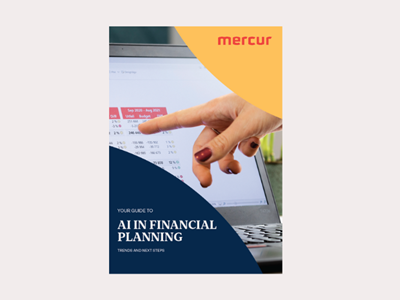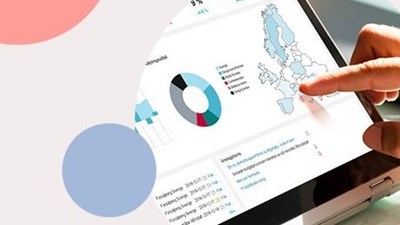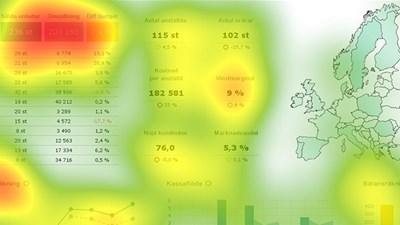.jpg?TS=638930093608527972)
Cash Flow Forecasting with Mercur's Advanced Tools
Inaccurate cash flow forecasting can be a costly mistake for companies. In today’s volatile market, relying on static annual budgets or manual spreadsheets leaves financial leaders without the agility to respond to uncertainty. This lack of accuracy not only undermines strategic decision-making but also risks inefficient working capital deployment and potential liquidity crises.
The solution is to transform forecasting into a continuous, strategic process with the help of advanced corporate performance management (CPM) software. Mercur Business Control enables organisations to move beyond traditional approaches, giving the C-suite greater confidence in cash visibility while turning forecasting into a true strategic advantage.
Continue below to explore how Mercur helps you achieve accurate, dynamic, and value-driving cash flow forecasting.
Basic Components of Effective Cash Flow Forecasting
Several key elements shape the successful cash flow forecasting. It begins with comprehensive data integration, ensuring that forecasts reflect the complete financial picture rather than isolated departmental views. This integration brings together information from:
ERP systems
CRM platforms
Bank APIs
External market sources
Historical analysis is another component that examines past performance patterns, seasonal variations and trend developments. It allows organisations to build more accurate predictive models. However, the historical perspective must be balanced with forward-looking indicators and market intelligence to capture emerging opportunities and risks.
Organisations use cross-departmental collaboration to increase their forecasting accuracy. Their sales teams provide pipeline visibility and market trend insights. At the same time, the procurement departments contribute supplier payment schedules and expense projections. Production planning data is the responsibility of operations teams, while HR departments provide workforce cost forecasts.
Mercur's Advanced Forecasting Capabilities
Mercur Business Control uses its corporate performance management platform to transform the traditional forecasting challenges. The system's flexible input accommodates detailed operational planning and strategic financial forecasting. It easily adapts to various business environments without compromising on accuracy and efficiency.
This financial forecasting software helps organisations cut their budgeting cycles by up to two-thirds. Mercur helps teams to transform what traditionally takes 12 weeks into a 4-week process. This is done through the combination of ERP and CRM imports with instant consolidation and built-in workflow controls.
Furthermore, multinational organisations can manage cash flows across different jurisdictions with the help of the currency conversion functionality. What the system does is automatically convert currencies and simulate different exchange rate scenarios. Organisations get direct insights into the global cash management strategies.
The Power of Rolling Forecasts
When searching for the most significant advancement in modern cash flow forecasting methodology, consider rolling forecasts. Unlike the static budgets that quickly become outdated, rolling forecast models maintain relevance throughout the year. What it needs is constant incorporation of new data and extension of the planning horizon as time progresses.
Companies use rolling forecasts to achieve better accuracy and reduce budget preparation time by half, while also increasing profitability. Organisations use Mercur's rolling forecasts to maintain forward-looking visibility that extends beyond the current fiscal year. This is also supported by strategic investment planning, resource allocation decisions and long-term growth strategies.
Scenario Analysis and Risk Management
Organisations can use an effective scenario planning simulation to quickly analyse the effects of changing circumstances at multiple levels. Advanced cash flow forecasting needs scenario analysis in order to prepare for various potential outcomes. The system immediately recalculates and displays results in the event business drivers for specific departments or products change.
It's a feature that has proven to be invaluable during periods of uncertainty. It helps finance teams to model optimistic, pessimistic and most likely scenarios in order to understand potential cash flow ranges and prepare contingency plans. Stress-testing against various assumptions supports proactive risk management.
It's worth knowing that scenario planning is complemented by variance analysis, where actual results are compared against forecasted performance. When organisations understand where and why variances occur, they can refine their forecasting methodologies and improve future accuracy.
Automation and Efficiency Gains
Financial teams know best that manual forecasting processes take up so much of their valuable time. Not to mention the unnecessary errors that are made along the way. All this can be a thing of the past with Mercur's automation features, which ensure consistent processes and timely completion of forecasting cycles.
The integration of automated payment systems also contributes to forecasting accuracy because it eliminates any cash outflow uncertainties. Finance teams can rely on accurate timing for cash flow projections only when payments are processed based on predetermined schedules.
Furthermore, the real-time data processing is used in forecasts to reflect the current business conditions rather than outdated assumptions. With the occurrence of transactions and the changing business conditions, forecasting models can automatically incorporate new information while, at the same time, maintain relevance and accuracy.
Integration with Enterprise Systems
Teams that are thinking about implementing modern cash flow forecasting in their organisation should know that it requires a smooth integration with the existing enterprise systems. Mercur can integrate with ERP systems, CRM platforms and financial institutions through secure APIs. It's a great way to eliminate manual data entry and ensure forecast models work with complete and current information.
The platform's database capacity can accommodate growing organisations without degrading their performance. The system scales with the expansion of the business and maintains the processing speed and analytical capabilities. Organisations can also integrate with business intelligence tools and reporting systems to create their analytical views. This allows them to present complex forecasting data in accessible and actionable formats that will facilitate their decision-making.
Implementing Advanced Forecasting Practices
Organisations that want to have a successful implementation of advanced cash flow forecasting must enforce careful planning and systematic execution. It starts with defining clear objectives for forecasting initiatives, whether focused on liquidity management, strategic planning or risk reduction. It is these objectives that guide the system configuration and process design.
The first step is to make sure that the data is legit. The accuracy of forecasts depends on having clean, complete, and reliable data. Before using advanced forecasting tools, companies should fix any data problems, like missing information or errors.
It's also important to help finance teams adapt to new ways of working, including learning new processes, technologies and teamwork methods. Good training is another tool that helps everyone use forecasting tools well while keeping things accurate and efficient.
Future-Proofing the Forecasting Strategy
Forecasting evolves along with the appearance of new technologies and methodologies. Tools like artificial intelligence and machine learning support predictive analytics by helping to spot the trends and patterns that human analysts might miss. While these technologies enhance the forecasting accuracy and efficiency, maintaining human oversight is still needed.
Cloud-based systems make forecasting easier to scale and collaborate on, no matter where team members are. Updates happen automatically without the need to interrupt the working process. It's also important to understand that forecasting goes beyond the internal business metrics. Integrating the forecasts with outside data like economic indicators, market research data and industry benchmarks will give companies additional context for forecasting models.
Measuring Forecasting Success
Effective forecasting strategies require organisations to track how well they are doing. This means monitoring key performance indicators to determine:
The accuracy of forecasts
The efficiency of the forecasting process
The assessment of how forecasts impact business decisions
Organisations that wish to measure their forecasting success should do regular checks to help them find where to improve and monitor progress over time. Forecast accuracy usually improves as companies refine their methodologies and accumulate more historical data. However, accuracy alone is insufficient. Forecasts must also support decision-making and provide actionable insights for business leaders.
Final Thoughts
The bottom line is that optimising cash flow forecasting requires advanced platforms that integrate data, automate tasks and support teamwork. Based on the above, we know that Mercur Business Control offers these features through its all-in-one corporate performance management platform.
It helps organisations turn forecasting from a one-time task into an ongoing strategic advantage. The combination of rolling forecasts, scenario analysis and real-time data integration gives them the confidence to manage uncertainty and respond quickly to changing conditions.
Success in cash flow forecasting greatly relies on adopting new technology, encouraging collaboration, and focusing on continuous improvement. Therefore, organisations that invest in these advanced tools and practices are better prepared to seize opportunities and manage risks.
 Blog
BlogScenario Planning - Better control during uncertain times
Uncertain times create the need for more frequent forecasts and time for analyzing and comparing different future scenarios. We give you 5 tips on how to simulate future scenarios using scenario planning
 Blog
BlogHow EPM Transforms Financial Planning and Forecasting
Struggling to keep plans aligned in a changing market? Discover how EPM helps finance teams move faster, stay accurate and lead with real-time insights.
 Blog
BlogWhy is our Excel-based budget always out of date?
Excel creates outdated budgets. Every time someone enters a figure, sends a file, or waits for another department to finish their section, your budget falls further behind reality.
 Blog
BlogHow to succeed with your planning, budgeting, and forecasting process
We know it can be challenging to succeed with your planning, budgeting, and forecasting process. Therefore, we have gathered our best tips for you to succeed!
 Blog
BlogWhy xP&A is a powerful game-changer
The newest iteration of planning, analysis and reporting systems is a powerful game-changer that unites company departments and boosts competitiveness. It’s called xP&A – the abbreviation of extended financial planning and analysis.
 Blog
BlogTop-Down vs Bottom-Up Budgeting
Budgeting aligns resources with strategic goals, and there are two primary approaches: top-down and bottom-up. Which method wroks best?
 Blog
BlogManagement Reporting Guide: Definition and Tips
Management reporting helps you see what’s really happening in your business. In this guide, we’ll explain what managerial reporting looks like and share practical tips.
 Blog
BlogFP&A Trends Shaping Financial Planning in 2025
Many organisations cope with fragmented planning and data quality issues, which slow down their forecasting cycles. This forces organisations to take practical steps to turn ambition into execution.
 Blog
BlogThe Role of the CFO: Top Priorities and Responsibilities
Today's finance leaders steer more than just budgets and reports. The digital transformation ramps up with the increase of corporate complexity, and so does the role of CFOs.
 Blog
BlogThe Business Benefits of Integrated Business Planning
This blog explores what IBP is and the typical IBP process. We highlight business benefits and how the right software can be a game-changer for your organisation.
 Blog
BlogBudgeting in a modern world
Thirty years after its debut, Microsoft Excel is still the preferred tool for budgeting and planning projects. However, its popularity is declining, due in most part to the rise of technology and subscription-based pricing for a myriad of SaaS-based products.
 Blog
BlogBetter Revenue Planning
Sales forecasting is the process of predicting future revenue based on past data and trends. Read the blog to learn the best methods to do it right.
 Blog
BlogVariance Analysis: A Comprehensive Guide
Senior executives are demanding more detail in their management reports. The amount of data available to finance departments has exploded and decision makers see this as an opportunity to get more insight into how the business is performing.
 Blog
BlogInformed Business Decisions at Maximum Velocity
The ability to process information swiftly is essential. If your business can’t manage your data efficiently, your company’s financial performance will surely underperform. At Mercur we have developed our own database Veloxic which helps Financial Planning and Analysis.
 Blog
BlogHow to Effectively Budget with Driver-Based Forecasting
Traditional models of forecasting rely on historical data and beliefs. It uses techniques that identify patterns, which are simple to use. However, with these methods, there are some challenges because they are not dynamic with today’s market, and can’t effectively analyse complex data.
 Blog
BlogBusiness Intelligence Reporting For Finance Teams
The real challenge today isn’t collecting data, it’s making sense of it and fast. Organisations turn to business intelligence (BI) to convert raw data into insight.But how do you actually do it right?
 Blog
BlogWhat Is FP&A? Definition, Purpose, and Best Practices
Without solid financial planning and analysis (FP&A), businesses operate in the dark. In this post we go deeper into the process of FP&A and why it’s important for businesses.
 Blog
BlogThe Collaborative, Smarter Budget
In many organisations manual budgeting processes over-burden staff and create masses of data which overwhelms department heads and stops them seeing the bigger picture.
 Blog
BlogTop 7 Manager KPIs for Financial and Operational Success
In today's post we'll break down why KPIs matter, which ones offer the most insight for finance and executive teams and how to ensure they're actually driving results.
 Blog
BlogTop PowerBI Alternatives in 2025
Explore the top PowerBI alternatives for 2025. Discover how Mercur delivers integrated planning, budgeting and reporting without the high cost and complexity.
 Blog
BlogWhat is Corporate Performance Management? (CPM)
CPM, or Corporate Performance Management, is a process within corporate management aimed at measuring and optimizing the performance of an organization. CPM encompasses a range of activities, including budgeting, planning, forecasting, reporting, and analysis.
 Blog
BlogRolling Forecasts: Practical Steps, Benefits, and How to Get Started
Financial planning has changed. Traditional annual budgets can’t keep up with rapid shifts in the market, evolving customer needs, and internal performance dynamics. That’s why many finance teams are turning to a rolling forecast model.
 Blog
BlogBalancing Profitability and Sustainability
Sustainability has become a central concern for organisations across the world — and the UK is no exception. This evolving landscape places new demands on financial reporting.
 Blog
BlogThe Hidden Cost of Data Silos
If you ever feel like your teams speak different languages when it comes to data, it is a classic symptom of data silos. The information gets stuck in one department, system or tool, making it difficult for anyone to see the full picture.
 Blog
BlogA practcial guide to scenario planning
Scenario planning gives you a clear, practical way to test assumptions, spot risks and opportunities, and make better strategic choices so your organisation stays resilient when conditions change.
 Blog
BlogSpreadsheets Risk the Future of the Business
Spreadsheets often start as just a list for storing information and there is minimal process documentation, support or maintenance for these worksheets. Despite the fact that desktop applications such as Microsoft Office are included in the standard configuration of users' PCs, very little formal training is ever given to spreadsheet users.
 Blog
BlogFive tips for a successful budget process!
How can you make your budget process more successful and maximise the effort that was invested in creating it? Of course, there are many factors to consider but we’ve chosen to highlight five key areas that will enable and help you create a smoother, value-creating and collaborative budget process.
 Blog
BlogBuild Long-Range Planning for Business Success
Discover how effective long-range planning aligns strategy, finance and operations for smarter decisions and sustainable growth.
 Blog
BlogHow Automated Reporting Will Transform FP&A in 2026
This article highlights the power of report automation, how to implement it in your business and explores any new opportunities for accurate financial analysis in the long run.
 Blog
BlogZero-Based vs. Incremental Budgeting
Budgeting sits at the heart of sound financial management. This is why choosing the right technique is crucial for CFOs – it shapes resource allocation, cost control and strategic agility. Incremental and zero-based budgeting are two leading methods that offer distinct approaches.
 Blog
BlogFrom static budgets to agile financial management
Traditional budgeting has long been the cornerstone of financial planning in businesses. But today it can become more of a limitation than a strength. That’s where the concept of Beyond Budgeting comes in.
 Blog
BlogAI in Finance as a Powerful Tool
In this post, we explore how AI is evolving from a theoretical concept into a valuable resource for decision-making. Get useful insights for finance teams at any stage, from early exploration to actively using AI-powered solutions.
 Blog
BlogHow to get accurate financial reports without waiting for month-end
You don't need to wait until month-end to see accurate financial reports. With modern financial systems you can access up-to-date reports whenever you need them.
 Blog
BlogAI and Machine Learning, what is it, and why is it important for the future?
Artificial Intelligence and Machine Learning, what is it, and what is the difference?
 Blog
BlogAI in Financial Planning: Trends and Next Steps
Discover how finance teams are using AI to drive smarter planning, faster insights, and stronger business decisions.
 Blog
BlogSpreadsheet Risk Management: Best Practices for 2025
Excel has long been a target for hackers; just one click on a malicious attachment can infect your entire network. So, how can you keep using spreadsheets while not sacrificing your safety?
 Blog
BlogAI in corporate budgeting
Artificial Intelligence (AI) can support decision making in key areas such as budgeting, capital allocation and even corporate strategy and as a result, it is increasingly being deployed in corporate performance management tools (CPM).
 Blog
BlogHow To Create a Successful Budgeting Process
When done well, budgeting helps organisations stay financially on course, even when things don’t go exactly as planned. Learn how to keep things on track so you avoid surprises and stay focused on your goals.
 Blog
BlogHow do finance teams track KPIs across the entire organisation?
Learn how finance teams track KPIs across the entire organisation by consolidating data from multiple sources into a unified system like Mercur.
 Blog
BlogThe Powerhouse of EPM Tools
A business’s success heavily relies on having a strong strategy. However, what's even more important is implementing that strategy while tracking and measuring the performance. This can easily be done by investing in enterprise performance management (EPM) software.
 Blog
BlogMastering Spreadsheets
Where many businesses start small, a simple spreadsheet can adequately perform the limited tasks required of it. As the company grows, your spreadsheets can get more complex and harder to manage, by which point it feels like it will be too difficult to move to a different reporting tool.
 Blog
BlogHow can AI help CFOs make better decisions?
Artificial Intelligence (AI) has significant potential to enhance decision-making for Chief Financial Officers (CFOs) by providing data-driven insights, automating routine tasks, and enabling more accurate forecasts.
 Blog
BlogBoost Report Readability, Engagement, and Decision-Making
In today’s fast-paced business environment, effective reports and dashboards are crucial for decision-making. Our user study using eye-tracking technology revealed seven key insights into what captures attention.
 Blog
BlogWhat is management reporting?
Management Reporting refers to the process of creating, analyzing, and presenting information about various aspects of an organization's performance to enable decision-makers to make well-informed decisions about the future.
 Blog
Blog3‑Statement Model for Better Financial Forecasting
Financial forecasting is critical for any business that wants to adapt to change. But finance teams keep usingfragmented models and manual processes. The 3-statement financial model is the solution.
 Blog
BlogSpreadsheets are not Collaborative Tools
Spreadsheets were never designed for collaboration, yet they are the single most used program among teams and co-workers. They often start out as a quick document for storing, formatting or calculating information but evolve into important documents and are often the core records for an organisation.
 Blog
BlogSave time and create a successful budget process
If you’re working in a large organization, you’re probably aware of how time-consuming the budget process can be. In this article we’ll give you tips on how to save time and still create a successful budget process
 Blog
BlogBest Guide to Improve Your Revenue with Flexible Budgeting
Optimise your expenses with flexible budgeting, and learn how to adjust budget to reflect current business activities, market changes and cost fluctuations.
 Blog
BlogWhat Is Planning, Budgeting and Forecasting?
Planning, budgeting and forecasting are rarely static. Shifts in the industry often require you to revisit assumptions, adjust targets and adopt new processes. Learn how to strengthen your approach and stay ahead of change.
 Blog
BlogRisks with working in spreadsheets
Spreadsheets are an essential tool for all types of organisations and businesses rely on them heavily, particularly for financial computations. The most popular spreadsheet program globally is, of course, Microsoft Excel, it’s used by an estimated 750 million people.
 Blog
BlogBusiness Budgeting Software: How to Choose the Right One
Choosing budgeting software is partly a finance and partly a strategic decision. The right tool helps organisations organise planning cycles, adapt as the market changes and increase accountability across departments. But not every platform will be a good fit.


















































